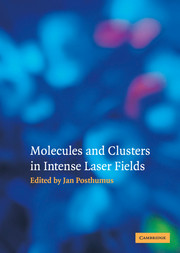Book contents
- Frontmatter
- Contents
- Preface
- 1 Ultra-high-intensity lasers based on Ti: sapphire
- 2 Diatomic molecules in intense laser fields
- 3 Small polyatomic molecules in intense laser fields
- 4 Coherent control in intense laser fields
- 5 Experimental studies of laser-heated rare-gas clusters
- 6 Single-cluster explosions and high-harmonic generation in clusters
- 7 Interactions of intense laser beams with extended cluster media
- Index
3 - Small polyatomic molecules in intense laser fields
Published online by Cambridge University Press: 29 March 2010
- Frontmatter
- Contents
- Preface
- 1 Ultra-high-intensity lasers based on Ti: sapphire
- 2 Diatomic molecules in intense laser fields
- 3 Small polyatomic molecules in intense laser fields
- 4 Coherent control in intense laser fields
- 5 Experimental studies of laser-heated rare-gas clusters
- 6 Single-cluster explosions and high-harmonic generation in clusters
- 7 Interactions of intense laser beams with extended cluster media
- Index
Summary
Introduction
The multiple ionisation of small molecules is being studied with various excitation sources, e.g. ionisation by ion or electron impact, synchrotron radiation, beam-foil electron stripping and intense laser pulses. Since multiply charged molecular ions are unstable, the process of ionisation itself is investigated by analysing the multiply charged atomic fragments. The multiple fragmentation channels are determined using various experimental techniques adapted to the excitation sources. These methods present some similarities to other fields in physics, such as particle and nuclear physics, in which the fragmentation of particles and nuclei plays an important role. This chapter starts with some general considerations about the laser excitation of small molecules and then continues to discuss the physics and the experimental techniques that are associated with laser-induced multiple ionisation. The physical quantities are expressed in atomic units (a.u.), MKSA units and practical units such as W cm−2 for the laser intensity. Most of the atomic- and molecular-spectroscopy data are taken from standard textbooks, for instance the books of Herzberg for neutral and singly charged molecules. The transient molecular ions, which remain undetected but appear as the precursors of the observed multiple fragmentation channels, are noted in square brackets, for example [N2O9+].
Timescales
The laser field presents basically two timescales: the optical period T = λ/c, where λ and c are, respectively, the laser wavelength and the speed of light, and the duration of the laser pulse.
- Type
- Chapter
- Information
- Molecules and Clusters in Intense Laser Fields , pp. 84 - 113Publisher: Cambridge University PressPrint publication year: 2001
- 5
- Cited by



